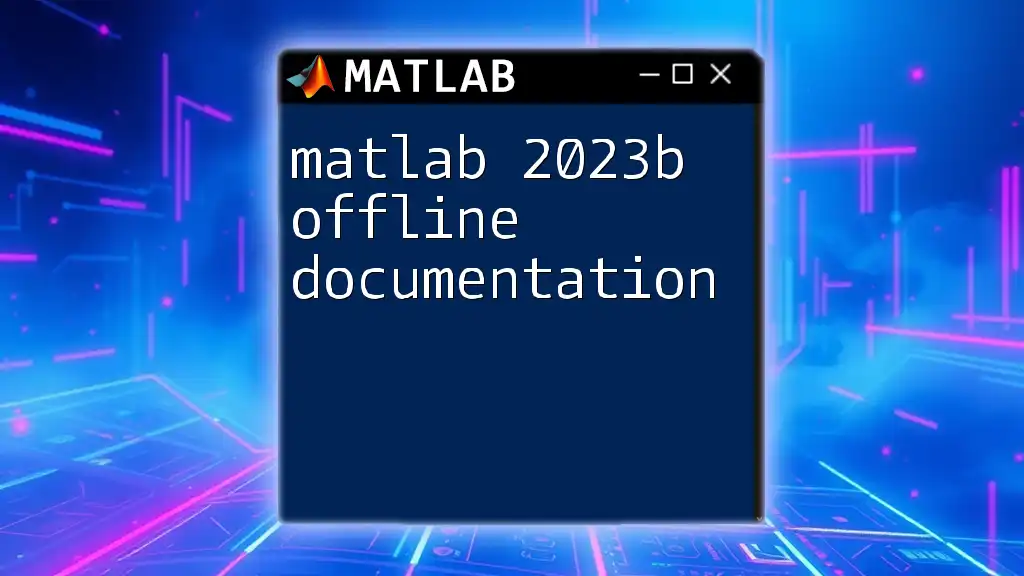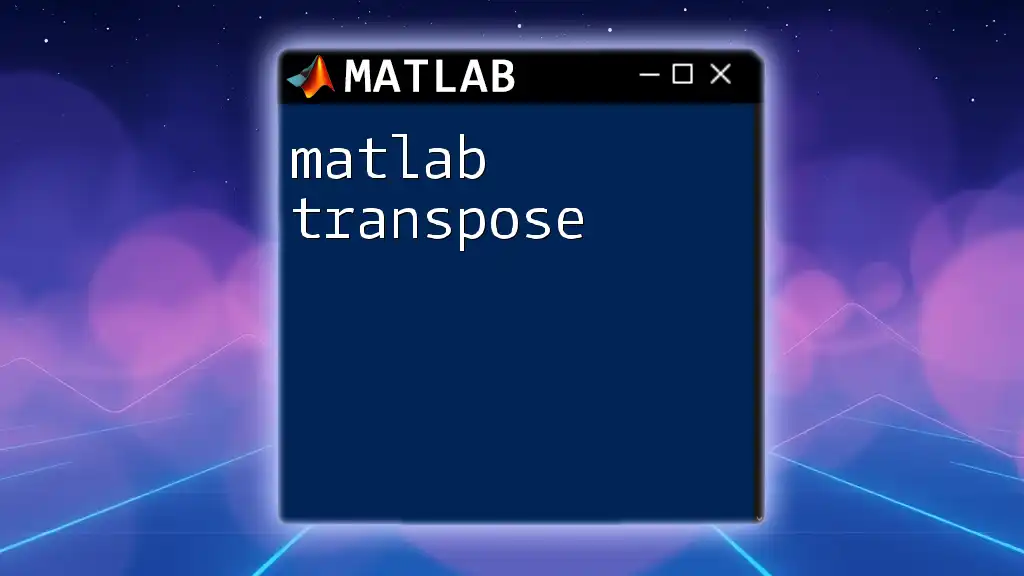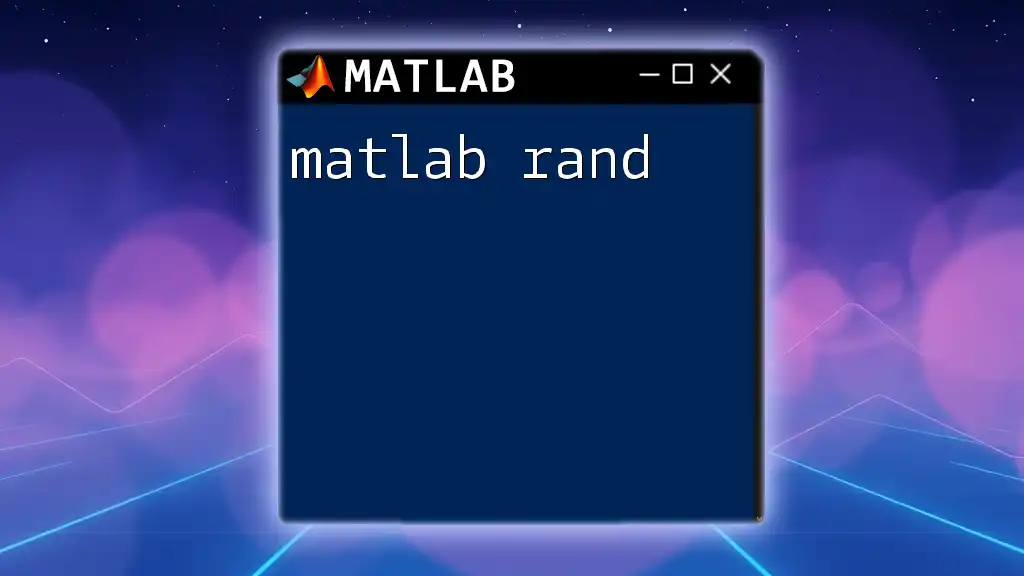"MATLAB 2023a introduces several enhancements and features that improve user experience and performance, making it essential for efficiently executing mathematical computations and data analysis."
Here’s a simple example to create a 2D plot in MATLAB:
x = 0:0.1:10; % Define the x values from 0 to 10 in increments of 0.1
y = sin(x); % Compute the sine of each x value
plot(x, y); % Create a 2D plot of y versus x
xlabel('x'); % Label the x-axis
ylabel('sin(x)'); % Label the y-axis
title('Sine Wave'); % Add a title to the plot
grid on; % Enable the grid for better readability
What’s New in MATLAB 2023a
Key Features
Enhanced Performance
MATLAB 2023a comes with significant performance upgrades that enhance the capability of handling large datasets and executing complex calculations. Users can expect improved computation speed, which directly influences productivity. To make the most of this performance improvement, consider optimizing your code by minimizing loops and utilizing built-in functions designed for efficiency.
New Functions
This version introduces new built-in functions that expand the functionality of MATLAB. For example, the function `predictor` allows for faster and more intuitive machine learning modeling. Here is a simple code snippet demonstrating its usage:
data = readtable('yourdata.csv');
mdl = fitlm(data, 'Response ~ Predictor1 + Predictor2');
predictions = predictor(mdl, newData);
User Interface Changes
Updated Desktop Environment
The user interface has received a fresh design that makes it easier to navigate and customize. Toolbars can be adjusted to display most-used functions prominently. This streamlined layout can greatly enhance the user experience as it enables quick access to relevant tools and functions.
Toolbox Enhancements
MATLAB 2023a also includes significant updates to essential toolboxes like the Statistics and Deep Learning Toolbox. For instance, advanced options for data preprocessing and new algorithms for model training enable data scientists to build more robust models with less effort. Familiarizing yourself with these updates will enhance your analytical capabilities.

Getting Started with MATLAB 2023a
Installation Guide
System Requirements
Before installation, ensure your system meets the minimum hardware requirements for MATLAB 2023a. Required specifications often include sufficient RAM (at least 8 GB) and a modern processor.
Step-by-Step Installation Process
- Download the installation package from the official MathWorks website.
- Run the installer and follow the on-screen prompts.
- Specify your installation type and select the necessary toolboxes.
- After installation, verify that MATLAB starts correctly and all toolboxes are accessible.
Should you encounter any common installation issues, consider consulting the FAQ section on the MathWorks site or seeking assistance in community forums.
Basic Commands and Syntax
Your First MATLAB Command
Starting with basic commands is the best way to familiarize yourself with MATLAB. For example, executing a straightforward calculation can be done as follows:
a = 5;
b = 10;
c = a + b;
disp(c)
This outputs `15`, demonstrating the simplicity and power of MATLAB for basic arithmetic operations.
Understanding the Command Window
The Command Window is where you'll spend a significant amount of time while using MATLAB. You can execute commands, view outputs, and debug code here. Customization options allow you to change the appearance and layout to suit your preferences.

Advanced Features in MATLAB 2023a
Programming Constructs
Variables and Data Types
Creating Variables
In MATLAB, you can create variables effortlessly. Stick to best practices for naming variables, making them descriptive for clarity. Here’s how to create a vector and a matrix:
row_vector = [1, 2, 3, 4];
column_vector = [1; 2; 3; 4];
matrix = [1, 2; 3, 4];
Common Data Types in MATLAB
MATLAB supports multiple data types, including arrays, matrices, and structures. Understanding the differences is crucial for efficient data handling. For example, a structure allows you to group different data types under one variable:
student.name = 'Alice';
student.age = 21;
student.grades = [90, 85, 88];
Control Flow Statements
If Statements
Control flow can manipulate the flow of execution based on conditions. Here is an example of implementing an if statement:
if a > b
disp('a is greater than b');
else
disp('b is greater than or equal to a');
end
Understanding these constructs is essential for writing conditional code that reacts appropriately based on user input or data analysis.
Loops
Loops allow you to execute a block of code multiple times. The `for` loop is particularly useful when the number of iterations is known:
for i = 1:5
disp(['Iteration: ', num2str(i)]);
end
Visualization Tools
Basic Plotting Functions
With MATLAB, data visualization is straightforward. For instance, plotting a simple sine wave can be done with:
x = 0:0.1:10;
y = sin(x);
plot(x, y);
title('Sine Wave');
xlabel('X-axis');
ylabel('Y-axis');
This snippet creates a visual representation, enhancing your ability to analyze and interpret data.
Customizing Plots
Adding titles, legends, and grid lines can clarify your plots, making them more informative. For example, you can customize your previous plot further:
grid on;
legend('sin(x)');

Applications of MATLAB 2023a
Simulations and Modeling
Creating Simulations for Engineering Problems
MATLAB excels in simulations, especially for engineering applications. For instance, you can simulate a simple mechanical system using differential equations, providing valuable insights into system behavior.
Using Simulink
Simulink, integrated with MATLAB, is a powerful tool for modeling and simulating dynamic systems. Familiarizing yourself with its graphical interface and block-based programming can significantly enhance your modeling capabilities.
Data Analysis
Importing and Exporting Data
MATLAB offers extensive options for data importation. Whether working with CSV, Excel, or databases, you can efficiently read and manipulate datasets. For example:
data = readtable('yourdata.csv');
Once imported, you can easily analyze and visualize the data.
Statistical Tools
The Statistical Toolbox in MATLAB provides various functions for performing statistical analyses. Functions like `mean`, `median`, and `standard deviation` facilitate quick and thorough data evaluations.

Best Practices for Effective MATLAB Programming
Code Organization
Function Separation
Organizing your code into functions contributes to better readability and reusability. Each function should achieve a specific task, allowing you to maintain a clean codebase.
Commenting and Documentation
Always include comments in your code to clarify your intentions. Well-documented code not only helps others but also serves as a reminder of your thought process when revisiting your work.
Performance Optimization
Profiling Code
To identify bottlenecks in your code, utilize MATLAB’s built-in profiler. This tool helps pinpoint sections of code that require optimization and improves your code's overall performance.
Vectorization Techniques
Where possible, vectorization can greatly speed up your computations by replacing loops with matrix operations. For example, instead of using a for-loop for element-wise operations, leverage matrix indexing:
A = rand(1000, 1000);
B = A.^2; % Instead of using a for-loop to square each element

Community and Resources
Online Resources for Learning MATLAB
Documentation and User Guides
The official MathWorks documentation is comprehensive, providing detailed information about every function and tool available in MATLAB. Always refer to it whenever you're unsure about a term or function.
MATLAB Central
MATLAB Central is an invaluable resource that connects users, allowing for community engagement, sharing of files, and troubleshooting. Engaging with this community can enhance your learning experience.
Continuous Learning
Webinars and Online Courses
Participate in webinars and online courses through MathWorks and other platforms. These resources often cover the latest updates, advanced techniques, and best practices.
Engaging with Forums and Groups
Join forums and groups related to MATLAB for peer support and knowledge sharing. Sites like Reddit, Stack Overflow, and dedicated MATLAB user groups can provide insights and solutions to common problems.

Conclusion
MATLAB 2023a enhances the programming experience with its powerful new features, performance improvements, and community resources. By adopting best practices and familiarizing yourself with the new capabilities, you can significantly elevate your MATLAB skills.

Call to Action
To take your MATLAB skills to the next level, consider signing up for upcoming classes tailored to teaching essential MATLAB commands effectively. By investing in your learning, you can unlock the full potential of MATLAB 2023a and enhance your analytical skills.

















